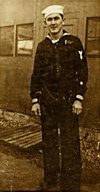
|

|
|
|
|
Gene was born in Fort Gibson, Oklahoma, to William Evers Boyd and Geneva Ann Hayworth Boyd as one of six children--four boys and two girls. Both girls died before he was born, one a victim of the 1918 influenza epidemic. During his childhood the family lived "in the middle of the oilfields," he says. He recalls his father as a "major entrepreneur" who hauled goods and raised horses, mules, and hogs. Gene began working very early in life. He recalls walking about "eight to ten" miles each day, first on a paper route, and then to catch a mule-powered school bus. At home he helped out with chores. He rode his Shetland pony to town to get ice, built fires under the black kettle in the yard on washdays, and walked "a little over half a mile" to draw water from a well and carry it home. Gene's mother died in 1936 when he was fourteen. Quitting school at the end of the tenth grade, he farmed, drove a bakery truck, and learned to operate his uncle's bulldozer. He began earning five dollars a day, driving the bulldozer to help clear land and build barns. He also moved earth in the oil fields, such as digging pits and cutting roads. On January 24, 1942 Gene married Imogene Bolding. (They would have three children, six grandchildren, and three great-grandchildren). Gene began working in March of 1942 for Fulshear and Pointer in Midwest City, Oklahoma, as a bulldozer operator. He was drafted in May of 1942, but before reporting for duty he volunteered for the Seabees in the U.S. Navy and took boot camp in Davisville, Rhode Island. "They didn't give us extensive training," he recalls. "They wanted people to work. I was on a boat leaving in ten weeks." On December 15,1942 Gene sailed from Norfolk for the South Pacific, as part of Company D (a heavy equipment company), 37th Construction Battalion. "We had old men," he says of his unit. "When we shipped out the first time our average age was thirty-eight." After a 33-day voyage the 37th arrived in New Caledonia, where Gene, operating a bulldozer, helped build an ammunition dump and ammunition houses for two naval bases. In September the 37th re-built facilities on Guadalcanal. A few weeks later they arrived at Mondo Point in the New Georgia Islands, and helped construct two airstrips on an island nearby despite enemy bombardment. "They shelled us for twenty-eight days every hour on the hour," he says. Meanwhile, Imogene wrote him a letter every day. "Sometimes I'd get them thirty at a time," he says. He helped build an airstrip on Green Island, where he arrived in February of 1944, and stayed until about October that year. The 37th returned to the States for five months. In April of 1945, Gene was sent to Okinawa where he and his fellow Seabees struggled to construct an LST dock. "I built it about three times and a hurricane would come along and wash it out," he says. He returned to America from Okinawa in November of 1945, weighing 121 pounds. He was discharged in Norman, Oklahoma. Gene went to work for his former company commander whose family owned M.A. Hanna in Hibbing, Minnesota, where he was put in charge of a mining crew. Returning to Oklahoma in November of 1946 Gene started his own business with four bulldozers and eight trucks moving heavy equipment such as oil rigs. The family later moved to Fort Smith where he founded Armor Express, an armored car service. Eight years later they moved to Kilgore, Texas. With his brother-in-law, Lloyd Bolding, a petroleum engineer, he opened a business in down-hole pumping of oil wells. Gene retired in 1986. Imogene passed away in July of 2006. In February of 2008 he married Rebecca White |


